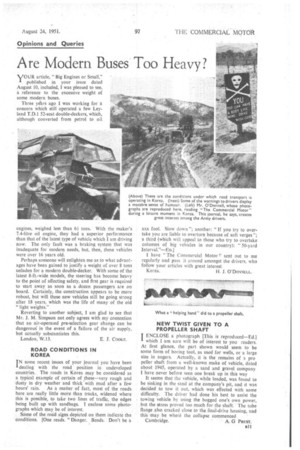Are Modern Buses Too Heavy?
Page 45

If you've noticed an error in this article please click here to report it so we can fix it.
VOUR article, "Big Engines or Small," I published in your issue dated August 10, included, I was pleased to see, a reference to the excessive weight of some modern buses.
Three years ago I was working for a concern which still operated a few Leyland T.13.1 52-seat double-deckers, which, although converted from petrol to oil.
engines, weighed less than 6i tons. With the maker's 7.4-litre oil engine, they had a superior performance than that of the latest type of vehicle which I am driving now. The only fault was a braking system that was inadequate for modern needs, but, then, these vehicles
were over 16 years old. .
Perhaps someone will enlighten me as to what advantages have been gained to justify a weight of over 8 tons unladen for a modern double-decker. With some of the latest 8-ft.-wide models, the steering has become heavy to the point of affecting safety, and first gear is required to start away as soon as a dozen passengers are on board. Certainly, the construction appears to be more robust, but will these new vehicles still be going strong after 18 years, which was the life of many of the old " light weights."
Reverting to another subject, I am glad to see that Mr. J, M. Simpson not only agrees with my contention that an air-operated pre-selection gear change can be dangeroug in the event of a failure of the air supply, but actually substantiates this,
London, W.13. E. J. COoKE.
ROAD CONDITIONS IN KOREA IN some recent issues of your journalyou have been I dealing with the road position in undeveloped countries. The roads in Korea may be considered as a typical example of certain of these—very rough and dusty in dry weather and thick with mud after a few hours' rain. As a matter of fact, most of the roads here are really little more' than tracks, widened where this is possible, to take two lines of traffic, the edges being built up with sandbags. I enclose some photographs which may be of interest.
Some of the road signs depicted on them indicate the conditions. [One reads. "Danger. Bends. Don't be a xxx fool. Slow down "; another: "If you try to overtake you are liable to overturn because of soft verges"; a third (which wilt appeal to those who try to overtake columns of big vehicles in our country): "50-yard In terva l."—Eo.]
I have "The Commercial Motor sent out to me regularly and pass it around amongst the drivers, who follow your articles with great interest.
Korea. H. J. O'DONNELL.
NEW TWIST GIVEN TO A PROPELLER 'SHAFT
ENCLOSE a photograph [This is reproduced—Ed.] I which I am sure will be of interest to youreaders. At first glance, the part shown would seem to be some form of boring tool, as used for wells, or a large size in augers. Actually, it is the remains of a pro peller shaft from a well-known make of vehicle, dated about 1945, operated by a sand and gravel company I have never before seen one break up in this way It seems that the vehicle, while loaded, was found to be sinking in the sand at the company's pit, and it was decided to tow it out, which was effected with some difficulty. The driver had done his best to assist the towing vehicle by using the bogged one's own power, . but the stress proved too much for the shaft. The tube flange also cracked close to the final-drive housing, and this may be where the collapse commenced
Cambridge. A. G PREST.




















































































